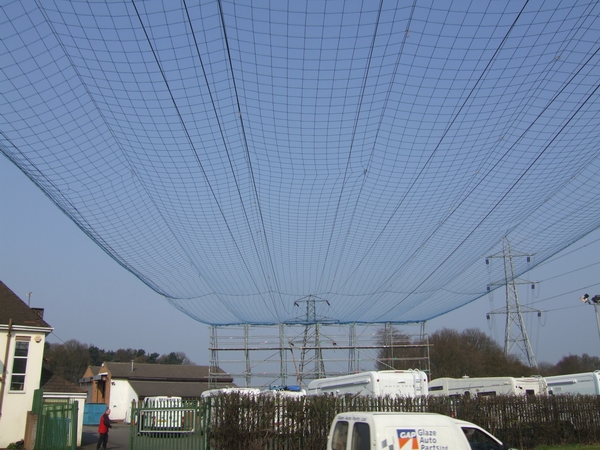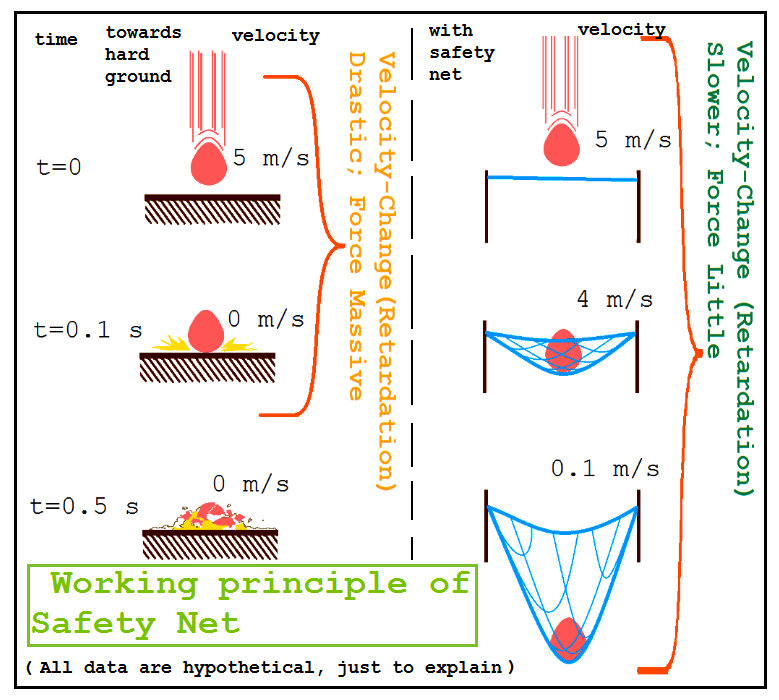safety net on:
[Wikipedia]
[Google]
[Amazon]
 A safety net is a
A safety net is a
 A safety net gives falling objects much more time to come to rest than hitting hard ground directly. In physical terms, this means more time for
A safety net gives falling objects much more time to come to rest than hitting hard ground directly. In physical terms, this means more time for
 Construction Safety nets are used at high-rise building construction sites for preventing accidental fall of people or objects from the site. Construction safety nets are the safest and cost effective fall prevention system in the world. Construction safety nets are flexible plastic nets made from
Construction Safety nets are used at high-rise building construction sites for preventing accidental fall of people or objects from the site. Construction safety nets are the safest and cost effective fall prevention system in the world. Construction safety nets are flexible plastic nets made from
Safety Net Systems
// Occupational Safety & Health Administration
Safety nets: Fall protection for the construction industry
/ National Safety Council Data Sheet 608, February 2006
Fall Protection in Construction, OSHA3146
/ U.S. Department of Labor Occupational Safety and Health Administration, 1998, page 6 "Fall Protection Systems Criteria and Practices", page 12 "Safety Net Systems"
Guide to Fall Protection Regulations
Workers Compensation Board, Canada, June 2013, page 11
A technical guide to the selection and use of fall prevention and arrest equipment
/ Glasgow Caledonian University for the Health and Safety Executive 2005 - "7.0 FALL ARREST NETTING (SAFETY NETS)" pp 107–138 Protective barriers Nets (devices)
 A safety net is a
A safety net is a net
Net or net may refer to:
Mathematics and physics
* Net (mathematics), a filter-like topological generalization of a sequence
* Net, a linear system of divisors of dimension 2
* Net (polyhedron), an arrangement of polygons that can be folded up ...
to protect people from injury after falling from heights by limiting the distance they fall, and deflecting to dissipate the impact energy. The term also refers to devices for arresting falling or flying objects for the safety of people beyond or below the net.
Safety nets are used in construction
Construction is a general term meaning the art and science to form Physical object, objects, systems, or organizations,"Construction" def. 1.a. 1.b. and 1.c. ''Oxford English Dictionary'' Second Edition on CD-ROM (v. 4.0) Oxford University Pr ...
, building maintenance, entertainment, or other industries.
Action of a safety net
 A safety net gives falling objects much more time to come to rest than hitting hard ground directly. In physical terms, this means more time for
A safety net gives falling objects much more time to come to rest than hitting hard ground directly. In physical terms, this means more time for deceleration
In mechanics, acceleration is the rate of change of the velocity of an object with respect to time. Accelerations are vector quantities (in that they have magnitude and direction). The orientation of an object's acceleration is given by t ...
and kinetic energy
In physics, the kinetic energy of an object is the energy that it possesses due to its motion.
It is defined as the work needed to accelerate a body of a given mass from rest to its stated velocity. Having gained this energy during its acc ...
transfer, resulting in a softer landing and much lower risk of damage.
What kind of net to be used, depends upon many factors, (such as the factors that could determine force of the impact) such as falling objects's speed and mass. To encounter more force, a more total width of the net, is required. The minimum distance of the spot on net at which object impacted, and the edge of net (nearest edge), matters, and to be kept more than certain limit. There is role of materials used to make the ropes of net (such as an iron rod grid will not work as good as flexible and extensible ropes), and the tension or stretch used to make the net (stored in the ropes), also have some roles. The net is to be set at an appropriate height from the hard ground, so that the object, along with the rope, does not clash with the hard ground. The mesh hole size should not be so big that falling object/people/part of it could pass through the holes.
Construction safety net
 Construction Safety nets are used at high-rise building construction sites for preventing accidental fall of people or objects from the site. Construction safety nets are the safest and cost effective fall prevention system in the world. Construction safety nets are flexible plastic nets made from
Construction Safety nets are used at high-rise building construction sites for preventing accidental fall of people or objects from the site. Construction safety nets are the safest and cost effective fall prevention system in the world. Construction safety nets are flexible plastic nets made from HDPE
High-density polyethylene (HDPE) or polyethylene high-density (PEHD) is a thermoplastic polymer produced from the monomer ethylene. It is sometimes called "alkathene" or "polythene" when used for HDPE pipes. With a high strength-to-density ratio, ...
or High-density polyethylene
High-density polyethylene (HDPE) or polyethylene high-density (PEHD) is a thermoplastic polymer produced from the monomer ethylene. It is sometimes called "alkathene" or "polythene" when used for HDPE pipes. With a high strength-to-density ratio, ...
raw materials. Construction safety netting system is also known as debris netting which can be installed both horizontally or vertically according to the requirements. The best practice of construction netting is to wrap up the whole construction site from bottom to top, which works as a protection wall to prevent anything from falling without blocking the view. Safety net installation at any building site requires professional expertise and technical knowledge.
Uses
Escape from a building during a disaster (including fire), construction-work, action-sports, etc.See also
* Construction site safety * Fall arrest harness * Roof edge protection * Shock absorber *Buffer (disambiguation)
Buffer may refer to:
Science
* Buffer gas, an inert or nonflammable gas
* Buffer solution, a solution used to prevent changes in pH
* Buffering agent, the weak acid or base in a buffer solution
* Lysis buffer, in cell biology
* Metal ion buffer ...
* Buffer stop
A buffer stop, bumper, bumping post, bumper block or stopblock (US), is a device to prevent railway vehicles from going past the end of a physical section of track.
The design of the buffer stop is dependent, in part, on the kind of couplings ...
* Buffer (rail transport)
A buffer is a part of the buffers-and-chain coupling system used on the railway systems of many countries, among them most of those in Europe, for attaching railway vehicles to one another.
Description
Fitted at the ends of the vehicle fram ...
* Damping ratio
* Damper (disambiguation)
A damper is a device that deadens, restrains, or depresses. It may refer to:
Music
* Damper pedal, a device that mutes musical tones, particularly in stringed instruments
* A mute for various brass instruments
Structure
* Damper (flow), a mecha ...
* Damped wave
Damping is an influence within or upon an oscillatory system that has the effect of reducing or preventing its oscillation. In physical systems, damping is produced by processes that dissipate the energy stored in the oscillation. Examples i ...
* Cushioning
Package cushioning is used to protect items during shipment. Vibration and impact shock during shipment and loading/unloading are controlled by cushioning to reduce the chance of product damage.
Cushioning is usually inside a shipping container ...
* Shock (mechanics)
A mechanical or physical shock is a sudden acceleration caused, for example, by impact, drop, kick, earthquake, or explosion. Shock is a transient physical excitation.
Shock describes matter subject to extreme rates of force with respect to tim ...
* Impact (mechanics)
* Jerk (physics)
* Impulse (physics)
* Collision
In physics, a collision is any event in which two or more bodies exert forces on each other in a relatively short time. Although the most common use of the word ''collision'' refers to incidents in which two or more objects collide with great fo ...
* Brake
* Terminal velocity
Terminal velocity is the maximum velocity (speed) attainable by an object as it falls through a fluid ( air is the most common example). It occurs when the sum of the drag force (''Fd'') and the buoyancy is equal to the downward force of grav ...
References
{{ReflistExternal links
Safety Net Systems
// Occupational Safety & Health Administration
Safety nets: Fall protection for the construction industry
/ National Safety Council Data Sheet 608, February 2006
Fall Protection in Construction, OSHA3146
/ U.S. Department of Labor Occupational Safety and Health Administration, 1998, page 6 "Fall Protection Systems Criteria and Practices", page 12 "Safety Net Systems"
Guide to Fall Protection Regulations
Workers Compensation Board, Canada, June 2013, page 11
A technical guide to the selection and use of fall prevention and arrest equipment
/ Glasgow Caledonian University for the Health and Safety Executive 2005 - "7.0 FALL ARREST NETTING (SAFETY NETS)" pp 107–138 Protective barriers Nets (devices)